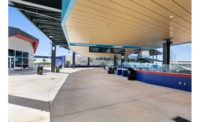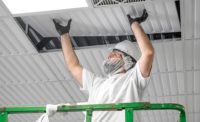The days of suspended ceiling tile being the biggest ceiling option are over. Ceiling options available today have never been greater. Given the desire for LEED principles in everyday buildings, light shelves, floating ceilings, clouds, exposed structures, and no ceilings are all options. Choices create challenges for MEP engineers to meet architectural vision while maintaining well-ventilated, brightly lit, draft-free, and sprinkler-protected spaces.
Today’s traditional ceiling approach—for both suspended and drywall ceilings—commonly uses standard 2x4 direct/indirect fluorescent lighting fixtures, 2x2 ceiling or slot diffusers with egg crate or registers for return air, and concealed sprinkler heads.
WHY A CEILING IS IMPORTANT
Diffusers (round and rectangular) and slot diffusers distribute airflow by discharging air parallel to the ceiling. The airflow follows the plane of the ceiling with velocity decreasing in relation to distance from the diffuser. The Coanda Effect helps airflow distribution: when a jet of air blows parallel to a surface, the lower static pressure caused by the air motion pulls the jet toward the surface. The most overlooked performance criteria in the selection of diffusers are temperature effects on cataloged performance data. Manufacturers typically present data based on an isothermal jet. Air density differential due to temperature differences modifies published data from isothermal conditions.
Ductwork is typically rectangular sheet metal insulated with flexible exterior duct wrap. Branch connections are generally round flexible run-outs to diffusers. Lights, whether recessed direct, indirect, or combination fixtures, use the ceiling to reflect light energy. The ceiling helps soften the light and adds uniformity to the space.
Power wiring is not usually dependent on the ceiling for operation, but relies on it as a concealing device. In a standard ceiling, the ceiling cavity may be used as a plenum, requiring the use of plenum-rated cable if not in conduit. Wiring above a ceiling is typically metal clad cable or, depending on the National Electrical Code, non-metallic sheathed cable. Although power wiring generally runs parallel and perpendicular to building lines, the appearance often depends on ceiling concealment.
TeleData/Special Systems are similar to power cable in that they generally require ceiling concealment. TeleData and special systems cabling is often a spider web above a finished ceiling emanating from a data closet or server room. Cables are bundled, hung on hooks, and dropped to wall outlets.
Sprinklers for standard fire protection use a fusible link that breaks when heated, allowing water to flow from the nozzle onto a deflector and be distributed into the room. Maintaining the heat adjacent to the sprinkler head is important for operation. The ceiling plays an integral role because it acts as a barrier to hold rising heat at sprinkler level.
REMOVING A CEILING
Given that the ceiling is important in the operation or concealment of MEP systems, removal of all or part of a ceiling affects systems performance and operation. Complete ceiling removal leaves the structure and underside of the roof or floor above exposed. It requires careful selection of components to ensure a comfortable space. One critical decision is whether or not ceiling components will be exposed and highlighted or painted to make them less noticeable.
|
The cost of complexity in each system typically outweighs the cost savings of ceiling removal. Airflow patterns at maximum and minimum flows need to be reviewed. Isothermal, full cooling, and full heating airflow patterns and their effect on throw and drop of airflow should be confirmed. Lighting requirements (utilizing calculations to ensure foot candles and uniformity within the space) should be reviewed. Colors and finishes should be selected that support the desired lighting scheme. Sprinkler protection is critical; shop drawing review of cloud materials will confirm that substitution does not require a change in sprinkler design. The impact of additional HVAC associated with the elimination of a plenum must not be underestimated. In general, a good partnership between the owner or user of a space, the architectural team, and the MEP engineering team can identify and resolve issues to create both a visually appealing and functionally efficient ceiling configuration. |
Typical construction of ceiling-less spaces includes exposed ductwork coupled with diffusers on duct drops. A horizontal pattern diffuser on a duct collar will have some airflow projecting upward toward the ceiling. A diffuser with an internal Coanda pocket on the diffuser face is desired. The horizontal throw is typically 25 to 30 percent less than an application with a ceiling. Of special interest are variable air volume applications where the discharge from the diffusers can reduce in relation to load. Due to the reduction in discharge velocity, diffusers can effectively lose Coanda Effect and drop columns of cold air, requiring a higher quantity of smaller diffusers to support the space. The higher the diffusers can be installed, the better the chance of mixing with room air and avoiding cool drafts.
Typically, ductwork must be insulated if the discharge air condition is below the dewpoint of the space in order for the unit to dehumidify. Non-insulated installations depend on outside airflow provisions, refrigeration type, and the owner’s tolerance to risk. There is always a potential for condensation on ductwork and the back panels of the diffusers. Generally, professionals will recommend against utilizing uninsulated ductwork. If someone holds a door open on a humid day, condensation will appear on the ductwork. For insulation, it is common to use double-wall ductwork to provide a hard exterior surface. Rigid ductwork insulation with a craft paper face will allow for a painted, insulated surface.
An exposed and highlighted structure typically includes a combination of direct and indirect light fixtures that provide uniformity of light when combined with a reflective surface finish. The number of fixtures and overall lighting load commonly increase with ceiling removal. There may be a corresponding increase in air conditioning load associated with the additional fixtures or the entire heat load of the lighting due to the elimination of a ceiling plenum. The impact is reduced with efficient LED fixtures. If the area above the ceiling is painted to disappear, and direct fixtures are utilized, uniformity of light is penalized. Lighting density calculations should be performed in either case to ensure the feel of the space is maintained. Care must be taken to avoid sway of pendant light fixtures due to HVAC airflow and building pressure changes.
In a highlighted structure plan, extra care will ensure conduit routing is performed in an architecturally pleasing manner. This can add cost and complexity, but is critical to the space.
Upright sprinkler heads are used in applications without a ceiling to protect the structure and the building interior. Sprinkler heads must be positioned to avoid discharge obstructions, and to sprinkler above and below objects that are wider than 48 inches (or smaller depending on insurance requirements).
PARTIAL AND CLOUD CEILINGS
Partial Ceilings and Clouds provide the complexity of no ceiling with some full-ceiling benefits. The cloud pattern and density affect the treatment.
Ductwork and diffusers in a partial ceiling are similar to an open ceiling with the exception of ensuring ceiling panels do not impede airflow or create drafts. Close coordination of diffusers and ceiling construction will confirm ceiling structure, lights, and sprinklers can coexist. Several options exist for integrating diffusers into cloud construction, including installing diffusers in the clouds, adjacent to the clouds to provide a ceiling for Coanda Effect, or simply distributing air between the clouds. Cloud sway due to air movement is another concern. Airflow impinging on wire-supported clouds or pendent-mounted light fixtures can result in noticeable sway that can be unsightly and costly to address after construction is complete.
Clouds add complexity and interest to the lighting scheme. Similar to a no-ceiling application, the amount of fixtures and overall lighting load commonly increase compared to a full ceiling. Preparation of lighting calculations is typically underestimated; however modeling daylight and nighttime light levels is necessary. The complexity of shading from the clouds and areas of reflectiveness on the panels make the process mandatory. Lighting density calculations should be performed in either case.
Cloud ceilings offer a chance to strategically lay out power and special systems to optimize the visual forgiveness of a full ceiling with the ease of access no ceiling provides.
Sprinklers generate the most complicated issues with a cloud ceiling. In general, the design will require upright heads and pendants for impediments to water flow. There is no magic bullet; solutions are dependent on code and insurance requirements. Sprinkler heads are often required in the floating clouds if the size of clouds is 48 inches or larger in either dimension, unless it is porous (typically defined as having a free area equal to 50 percent or higher). Some insurance carriers require sprinklers above and below objects 24 inches and wider. With less than 50 percent free area and more than 48 inches wide, sprinkler heads are needed in the cloud in addition to a draft collar or stop behind each head to ensure the heat of a fire does not bypass the head and prevent the thermal link from breaking.









